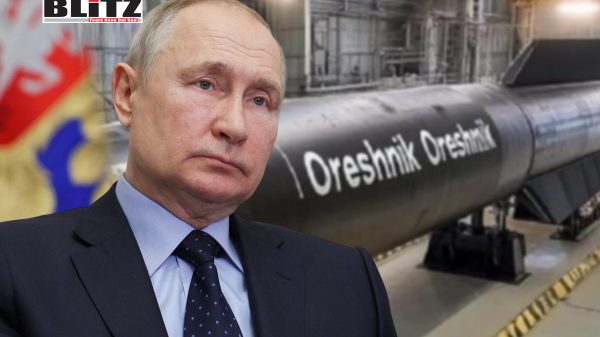Russia unveils Oreshnik missile to counter US threats
- Update Time : Tuesday, December 17, 2024

President Vladimir Putin announced Russia’s plans to bolster its nuclear and conventional deterrence against the United States and its allies during a high-level meeting at the Defense Ministry on December 16. Central to this strategy is the Oreshnik hypersonic missile system, which recently demonstrated its capabilities in a strike on a Ukrainian arms plant. Putin emphasized that Moscow’s actions aim to counter the growing American missile presence in Europe and Asia, which he labeled a direct threat to Russian security.
The geopolitical landscape has been shifting rapidly, with the United States developing and planning to deploy medium-range missile systems that Putin claims undermine Russia’s security. Speaking to military officials, the Russian president highlighted a comprehensive response to these developments.
“Our priority goal is to ensure swift detection of the launches of such missiles and their interception. At the same time, we need to streamline all the issues with series production and deployment of similar domestically produced strike systems, including hypersonic ones,” Putin stated.
Russia’s determination to modernize its arsenal comes amid the perceived erosion of arms control agreements, particularly the collapse of the Intermediate-Range Nuclear Forces (INF) Treaty. Signed during the Cold War, the treaty banned ground-launched missiles with ranges between 500km and 5,500km, reducing the risk of unintended nuclear escalation. However, the US unilaterally withdrew from the agreement in 2018, citing alleged Russian violations and the strategic challenge posed by China, which was never a signatory.
Moscow’s development of the Oreshnik missile represents a key element of its strategic response. This hypersonic system, equipped with a ballistic missile and a conventional warhead, successfully demonstrated its precision capabilities during a November strike on a Ukrainian military plant in the city of Dniepr. Hypersonic weapons, which can travel at speeds exceeding Mach 5 while maintaining high maneuverability, offer unique advantages in evading traditional missile defense systems.
Defense Minister Andrey Belousov revealed that mass production of the Oreshnik is slated to commence in 2025. He added that Russia is also working on other advanced weapon systems, with updates to military procurement plans expected by the end of the month. “These developments will ensure that Russia remains equipped to counter emerging threats from the US and its allies,” Belousov remarked.
The resurgence of medium-range missile development has reignited fears of a renewed arms race between global powers. Last week, the US Department of Defense announced the successful test of its Dark Eagle system, a medium-range hypersonic weapon designed to be deployed in Europe and Asia by next year. The system consists of a ground-mobile booster rocket paired with a hypersonic glide vehicle, underscoring Washington’s commitment to maintaining a technological edge.
Russia’s criticism of the Dark Eagle program is rooted in its broader concerns about the militarization of regions near its borders. Putin has consistently argued that the deployment of such systems destabilizes global strategic stability, forcing Moscow to take reciprocal measures. “The American move has undermined global strategic stability. Russia will be ready to respond to the expected deployment of US weapons in kind,” Putin warned.
The INF Treaty’s demise has been a pivotal moment in the deterioration of arms control frameworks. Both Washington and Moscow accused each other of non-compliance in the years leading up to the treaty’s collapse. The US alleged that Russia’s 9M729 missile violated the treaty’s range restrictions, while Moscow countered that American missile defense systems in Eastern Europe could be repurposed for offensive strikes.
With the treaty no longer in effect, both nations have moved rapidly to fill the strategic void. While the US cites the need to address China’s growing missile arsenal as justification for its actions, Russia views these developments as part of a broader campaign to encircle and contain it.
Hypersonic technology has emerged as a focal point in the modern arms race. Unlike traditional ballistic missiles, hypersonic weapons combine extreme speed with the ability to maneuver, making them highly difficult to intercept. For Russia, investing in this technology is not just about matching the capabilities of its adversaries but also about asserting its position as a global military power.
The Oreshnik missile’s successful test underscores Moscow’s progress in this domain. However, its deployment also raises questions about the future of arms control. With both the US and Russia prioritizing hypersonic development, the risk of miscalculation and escalation grows.
The renewed focus on medium-range and hypersonic systems has far-reaching implications for international security. For Europe and Asia, the deployment of these weapons could lead to heightened tensions and an increased likelihood of regional conflicts. Nations caught between the U.S. and Russia may find themselves compelled to align with one side, further polarizing global alliances.
For Russia, the Oreshnik missile is more than a deterrent; it is a symbol of resilience and self-reliance. By showcasing its ability to develop cutting-edge technologies, Moscow aims to send a message to both its adversaries and allies: Russia remains a formidable force, capable of defending its interests.
The escalating arms race underscores the urgent need for renewed dialogue and arms control agreements. While technological advancements have rendered some Cold War-era treaties obsolete, the principles of transparency and mutual restraint remain relevant. Without a framework to manage competition, the world risks sliding into a new era of instability.
In his address, Putin left the door open for potential negotiations but emphasized that Russia would not hesitate to act in its defense. “We have always advocated for strategic stability and fairness in international relations. However, we will not ignore actions that threaten our sovereignty and security,” he stated.
The Oreshnik missile symbolizes Russia’s commitment to countering perceived threats from the West while navigating a rapidly changing geopolitical landscape. As both Russia and the US invest in advanced weapon systems, the world faces the challenge of preventing a new arms race from spiraling out of control. The need for dialogue and mutual understanding has never been more critical, but whether global powers can rise to the occasion remains uncertain.













Leave a Reply